Explore an ancient French estate through the wildlife-loving eyes of Jean-François Magnan
Originally built by the knights of Chasteigner de la Roche-Posay in the 13th-century as a refuge on the road between Limoges and Angoulême, Domaine des Etangs stands as a safe haven of a different kind today, guarded by a man on a contemporary quest to preserve the natural beauty which abounds throughout the 1,000 hectare estate. Swapping the sword-wielding and steed-riding of his forefathers for the more peaceful pursuits of watching over the Domaine’s herd of Limousin cows, gathering chestnuts from the groves to roast over the fire, and tending the land with an ‘as nature intended’ approach, gamekeeper and forest ranger Jean-François Magnan is a modern-day defender of the land he calls home.
Hailing from Massignac, the neighbouring village of the Domaine, Jean-François lived in Paris and then in Toulouse for a few years, but felt uprooted everywhere he went. When he returned to his family, he sought out a role which would not only immerse him in nature every day, but also give him the opportunity to share his knowledge and passion for wildlife with others. Guests can join Jean-François for guided nature walks and wildlife-spotting sessions during their stay at the idyllic Domaine, unearthing the agricultural history of the estate’s outlying farmhouses along the way. The Considerate Collection property cultivates an organic permaculture vegetable garden, plants local tree species, and manages its forests according to PEFC certification standards. In simple terms, the Domaine is ‘green’ in every sense of the word – and Jean-François intends to keep it that way.
Tell us about the Domaine’s ‘harmony with nature’ ethos, and how you follow this day-to-day?
At Domaine des Etangs, a metaphysical link exists between us and nature. Far from the tumult of the cities, we rediscover the soft force of an ancestral link which unites us with nature and awakens the ‘sensitive’ part of our soul. Like our ancestors, we cultivate our garden as the seasons go by – the Domaine’s organic vegetable garden combines permaculture, which respects the life of the soil and allows for the sustainable production of fruit and vegetables, with aesthetics and landscape architecture, inspired by nature and serving the physiological needs of the plants. What could be more beautiful and yet so simple than to taste, in this garden, on a beautiful summer afternoon, a fleshy raspberry, full of juices and vitamins, in the middle of the flight of butterflies and heavy bumblebees gathering the flowers.
Like our forefathers, we raise our animals. The farm occupies most of the estate’s surface area
and shapes its landscapes with generous meadows, green with grass and dotted with a host of wild flowers, dedicated to our queen – the Limousin cow. Hundreds of generations of our region have lovingly pampered, selected and cared for this now famous breed of beef cow. The reputation of our herds dedicated to reproduction, of our imposing bulls with exceptional genetics has earned the estate a large number of awards, crowned by certification in organic farming.
Everything that the cows consume for their food, fodder, cereals and therefore straw, is produced on the estate without any chemical or external additives; but there is one thing that cannot be measured and which is nevertheless the heart of the success of a breeding in harmony with nature – the well-being of the animals, which certainly means giving them quality food, but also respecting their biological rhythms, the hierarchy of their social relationships, giving them a space that is commensurate with their natural needs. In short, leaving their instincts, specific to this rustic local breed, free to express themselves.

Like our ancestors, we communicate through art. Art is everywhere in the Domaine and especially in nature where beauty is present in each of its creations. The works present on the estate, especially those outdoors, which are displayed as closely as possible to their source of inspiration, are odes to nature. Through their meaning and materials, they celebrate life and nature. You could almost consider that these works, some of which have been crafted using local materials, are not finished since the wind, the weather, the air and the water continue to evolve the pieces at every moment.
Like our ancestors, we strive to pass on to our children. The generations that preceded us left
us an original built heritage, the know-how specific to this land, a natural, agricultural and forestry heritage of great wealth. Under the aegis of the National Museum of Natural History and its Agricultural Observatory of Biodiversity, we are setting up scientific protocols to assess the quality and permanence of our farmland through the evaluation of the presence of butterflies, solitary bees, but also soil fauna (earthworms, springtails, and sowbugs), which will ensure that we leave fertile and fruitful land to our children.
It is a great honour to share our knowledge and the effective results, in the field, of our sustainable agricultural practices that respect the cycles of nature, with our guests as well as with schoolchildren, who are today’s consumers and tomorrow’s producers. The beautiful forests of the Domaine, which have become so dear to my heart, are also the object of the greatest care because they are being threatened by global warming. What better gift to the Domaine than to see these oaks cared for, pampered, and protected, growing slowly, centimetre by centimetre, year by year.
”I must admit that every day at the Domaine, nature surprises and amazes me.
What is your favourite season in Massignac, and why?
Each season has its own particular charm. Winter, a time of rest for the vegetation, and unjustly seen as a harsh season, has the great virtue of making the fauna visible in the forests that have become clear. The pale, low-angled light gives a singular beauty to the farms lost in the landscape. Even the mists give the woods full of gaunt trunks and the moors covered with dry, shaggy grass a mysterious atmosphere which stirs the imagination.
As for spring, it will see the rebirth of plants and animals with the wonderful energy of life that drives them to feed and reproduce. Then, the days, little by little, will brightly illuminate the pastures of a raw green where the wheat brown coats of the placid Limousin cows and the myriads of bright yellow dandelion flowers will be in singular contrast.

But, without a doubt, autumn is my favourite season at the Domaine. Of course, we could evoke the beautiful colours of the forests, the gold of the beech and chestnut trees, but it is above all the culmination of the annual cycle, the time of fruit and abundance of all that nature produces as resources to face the hard winter. So, in the hedges and woods, there is a frantic race for food; birds gorge themselves on seeds and berries, small mammals such as squirrels and shrews hurry towards their burrows, their mouths full of nuts and wild berries, while in the evening, the stag, haughty and majestic, utters long, hoarse cries in order to attract the does.
It is also harvest time and it is with greed that I share with our hosts these moments of chestnut picking, lulled with stories in these venerable chestnut groves, emblematic of our land. Tasting them around a brazier with a glass of cider opens up a bouquet of smells and flavours and revives our childhood memories. At Dyades, the Domaine’s farm-to-table restaurant, the aroma of a few porcini mushrooms picked up on the estate already fills the room with the promise of a delicious meal.
What sort of wildlife can be found on the estate?
The first thing that comes to mind is obviously the large animals – deer and wild boar love this safe haven that is the estate and the right mix of forests, pastures, moors and wetlands which offer them security and food. But in addition to that, it is with pleasure that I invite our guests during our nature walks to lean towards the smallest creatures that we sometimes pass by without even noticing. The small flowers, with their nameless beauty, shelter within them a whole myriad of fabulous insects, which have become rare elsewhere; beetles with iridescent colours, spiders wearing their camouflage livery and waiting motionless like statues for their prey. Finally, the butterflies with their shimmering shapes and colours, gathering the delicious pollen.

Near the ponds, the herons, the egrets with their immaculate silhouettes, catch, from time to time, a fish wriggling between their beaks. On the banks of the ponds, where the mauve bouquets of medicinal loosestrife and marsh irises abound, a thousand and one dragonflies, the emblem of the Domaine, flutter like tiny comets.
What makes the surrounding forests, flora and fauna so special?
The originality of nature at the Domaine lies in two main aspects – its geography, how it has been shaped over millions of years by its different climates, and its geology; but also the terroir, that is to say, the way in which we have interacted with this environment, taming it in just a few millennia, and allowing ourselves to be shaped by it.
Through its climate, squeezed between the Massif Central and the oceanic coast bathed by the Gulf Stream, our beautiful region of Limousin, sitting on the edge of these old mountains worn by time, benefits from the invigorating rains of the west coast which have sculpted its landscapes. A land of trees and water, its clay skin, wrinkled by geological movements, and even by the fall of meteorites, sees a succession of small green hills in the hollow of which meander small streams that never dry up, arteries of water and life. Over time, these streams have nibbled away at the once lofty mountains, gradually revealing metamorphic rocks born in the depths of the earth hundreds of millions of years ago. Today, they distil an acidity and elements specific to the soil that give it a particular vegetation. Thus, since the end of the Pleistocene, our beautiful land has been covered with an abundance of woodland; oak and beech forests on the deepest land, gorse and birch on the poor, wind-beaten land.

Finally, the art of the country building, the numerous Romanesque churches with their striking painted frescoes and mysterious sculptures particularly evoke the authenticity of the soul of our land which is so well embodied by the Domaine des Etangs.
Where would you recommend for a country walk, to feel closest to nature?
This is a very difficult question as nature is everywhere at the Domaine and the evocative power of the elements is present at every moment – in the flight of a bird over the pond against the backdrop of the warm light at the end of the day, illuminating the beautiful stones of the farmsteads with their rough, collected forms; in the mist of a cool morning where we can guess more than we see, just making out the silhouettes of animals. However, two places come to mind, both of which are a bit like initiatory journeys when one sets out to discover them on foot.
Each step reveals a different landscape, a different atmosphere – in the first place, you will arrive in a place where the forest seems to end. The moor, bathed in a soft light and dotted with trees, seems to lead its own timeless, divine and almost mystical existence. In this place, a few deer play, toads called yellow-bellied toads croak, whose noise does not disturb the flight of dragonflies and the exhalation of thousands of tiny seeds of the marsh orchid known as Dactylorhiza maculata. At the Domaine, we call this place ‘the tree of a thousand trunks’ because on its fringe stands a curious, dishevelled sentinel: a beech tree with centuries-old roots, which unlike its fellow trees, discharges its inescapable life force through a large number of young trunks full of sap, giving the impression that it has a thousand.

The second walk, which is less well known to the Domaine, is also a beech tree, whose off-centre location imposes an almost secret discretion on this giant; once the scene of events that are still only spoken of in hushed tones in the region, even though they took place a long time ago during the French Revolution. I entrust you with these whispers which have been poured into the enormous hole serving as the ear of this beech, a colossus with a hollow trunk.





